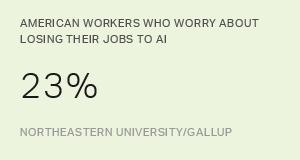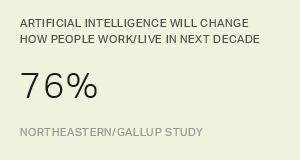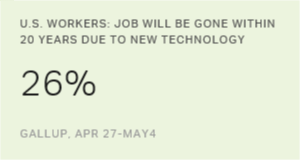Story Highlights
- 43% are confident they could obtain training
- 51% believe they would need new training or education
- 49% say they would look to employers to provide training
WASHINGTON, D.C. -- About half of U.S. workers (51%) agree or strongly agree that they would need additional education or training to secure an equivalent job if they lost their current one because of new technology. However, less than half (43%) are confident or extremely confident they could obtain this education or training.
| Extremely confident/ Confident (5, 4) | Neither confident nor not confident (3) | Not confident/Not at all confident (2, 1) | ||||||||||||||||||||||||||||||||||||||||||||||||||||||||||||||||||||||||||||||||||||||||||||||||||
|---|---|---|---|---|---|---|---|---|---|---|---|---|---|---|---|---|---|---|---|---|---|---|---|---|---|---|---|---|---|---|---|---|---|---|---|---|---|---|---|---|---|---|---|---|---|---|---|---|---|---|---|---|---|---|---|---|---|---|---|---|---|---|---|---|---|---|---|---|---|---|---|---|---|---|---|---|---|---|---|---|---|---|---|---|---|---|---|---|---|---|---|---|---|---|---|---|---|---|---|---|
| % | % | % | ||||||||||||||||||||||||||||||||||||||||||||||||||||||||||||||||||||||||||||||||||||||||||||||||||
| U.S. workers | 43 | 32 | 25 | |||||||||||||||||||||||||||||||||||||||||||||||||||||||||||||||||||||||||||||||||||||||||||||||||
| Age | ||||||||||||||||||||||||||||||||||||||||||||||||||||||||||||||||||||||||||||||||||||||||||||||||||||
| 18-35 | 52 | 31 | 17 | |||||||||||||||||||||||||||||||||||||||||||||||||||||||||||||||||||||||||||||||||||||||||||||||||
| 36-50 | 46 | 34 | 20 | |||||||||||||||||||||||||||||||||||||||||||||||||||||||||||||||||||||||||||||||||||||||||||||||||
| 51-65 | 34 | 31 | 35 | |||||||||||||||||||||||||||||||||||||||||||||||||||||||||||||||||||||||||||||||||||||||||||||||||
| Education | ||||||||||||||||||||||||||||||||||||||||||||||||||||||||||||||||||||||||||||||||||||||||||||||||||||
| Less than a bachelor's degree | 37 | 32 | 31 | |||||||||||||||||||||||||||||||||||||||||||||||||||||||||||||||||||||||||||||||||||||||||||||||||
| Bachelor's degree or higher | 53 | 31 | 15 | |||||||||||||||||||||||||||||||||||||||||||||||||||||||||||||||||||||||||||||||||||||||||||||||||
| Job type | ||||||||||||||||||||||||||||||||||||||||||||||||||||||||||||||||||||||||||||||||||||||||||||||||||||
| White collar | 51 | 33 | 16 | |||||||||||||||||||||||||||||||||||||||||||||||||||||||||||||||||||||||||||||||||||||||||||||||||
| Blue collar | 34 | 31 | 36 | |||||||||||||||||||||||||||||||||||||||||||||||||||||||||||||||||||||||||||||||||||||||||||||||||
| Note: Among employed Americans; due to rounding issues, percentages may add up to more than 100% | ||||||||||||||||||||||||||||||||||||||||||||||||||||||||||||||||||||||||||||||||||||||||||||||||||||
| Northeastern University/Â鶹´«Ã½AV survey, Sept. 15-Oct. 10, 2017 | ||||||||||||||||||||||||||||||||||||||||||||||||||||||||||||||||||||||||||||||||||||||||||||||||||||
These data come from a Northeastern University/Â鶹´«Ã½AV survey of Americans' attitudes toward artificial intelligence (AI) and its effect on their lives and work. The mail survey of 3,297 U.S. adults, including 2,871 who are employed, was conducted Sept. 15-Oct. 10, 2017.
College-educated, white-collar and younger workers are more confident than their counterparts that they could obtain the necessary training to secure an equivalent job. A 16-percentage-point confidence gap separates workers with a bachelor's degree or higher education (53%) and those with less than a bachelor's degree (37%). There is a similar gap between white-collar workers (those working in largely salaried industries) and blue-collar workers (those working in industries largely composed of hourly wage earners) -- 51% vs. 34%, respectively.
Workers with higher levels of education and those in white-collar fields tend to be more optimistic about AI, and their higher levels of confidence may reflect that.
The youngest American workers, those aged 18 to 35, are also among the most confident that they could obtain the training or education they would need to find a new job, with slightly more than half (52%) saying so. Confidence falls among workers in older age groups, with 46% of those aged 36 to 50 expressing confidence and 34% of those aged 51 to 65 saying the same.
Half of Workers Say They Would Need Additional Training
Unlike perceptions of having access to further training, there are no meaningful differences by age, education or job type when it comes to workers' perceptions that they would need such training.
| Strongly agree/Agree (5, 4) | Neither agree nor disagree (3) | Disagree/Strongly disagree (2, 1) | ||||||||||||||||||||||||||||||||||||||||||||||||||||||||||||||||||||||||||||||||||||||||||||||||||
|---|---|---|---|---|---|---|---|---|---|---|---|---|---|---|---|---|---|---|---|---|---|---|---|---|---|---|---|---|---|---|---|---|---|---|---|---|---|---|---|---|---|---|---|---|---|---|---|---|---|---|---|---|---|---|---|---|---|---|---|---|---|---|---|---|---|---|---|---|---|---|---|---|---|---|---|---|---|---|---|---|---|---|---|---|---|---|---|---|---|---|---|---|---|---|---|---|---|---|---|---|
| % | % | % | ||||||||||||||||||||||||||||||||||||||||||||||||||||||||||||||||||||||||||||||||||||||||||||||||||
| U.S. workers | 51 | 22 | 27 | |||||||||||||||||||||||||||||||||||||||||||||||||||||||||||||||||||||||||||||||||||||||||||||||||
| Age | ||||||||||||||||||||||||||||||||||||||||||||||||||||||||||||||||||||||||||||||||||||||||||||||||||||
| 18-35 | 47 | 24 | 29 | |||||||||||||||||||||||||||||||||||||||||||||||||||||||||||||||||||||||||||||||||||||||||||||||||
| 36-50 | 53 | 24 | 23 | |||||||||||||||||||||||||||||||||||||||||||||||||||||||||||||||||||||||||||||||||||||||||||||||||
| 51-65 | 53 | 21 | 26 | |||||||||||||||||||||||||||||||||||||||||||||||||||||||||||||||||||||||||||||||||||||||||||||||||
| Education | ||||||||||||||||||||||||||||||||||||||||||||||||||||||||||||||||||||||||||||||||||||||||||||||||||||
| Less than a bachelor's degree | 52 | 23 | 25 | |||||||||||||||||||||||||||||||||||||||||||||||||||||||||||||||||||||||||||||||||||||||||||||||||
| Bachelor's degree or higher | 47 | 21 | 32 | |||||||||||||||||||||||||||||||||||||||||||||||||||||||||||||||||||||||||||||||||||||||||||||||||
| Job type | ||||||||||||||||||||||||||||||||||||||||||||||||||||||||||||||||||||||||||||||||||||||||||||||||||||
| White collar | 52 | 21 | 28 | |||||||||||||||||||||||||||||||||||||||||||||||||||||||||||||||||||||||||||||||||||||||||||||||||
| Blue collar | 50 | 24 | 26 | |||||||||||||||||||||||||||||||||||||||||||||||||||||||||||||||||||||||||||||||||||||||||||||||||
| Note: Among employed Americans; due to rounding issues, percentages may add up to more than 100% | ||||||||||||||||||||||||||||||||||||||||||||||||||||||||||||||||||||||||||||||||||||||||||||||||||||
| Northeastern University/Â鶹´«Ã½AV survey, Sept. 15-Oct. 10, 2017 | ||||||||||||||||||||||||||||||||||||||||||||||||||||||||||||||||||||||||||||||||||||||||||||||||||||
American Workers Would Look to Employers for Education
Employed Americans were also asked to say which of five potential sources of training they would prefer if they lost their jobs to new technology. Nearly half (49%) say they would look to on-the-job training or other training offered by an employer. About one in five workers (21%) say they would prefer traditional programs at a college or university, while 16% would look to online programs at a similar institution.

Where American workers would turn for the training or education needed to find a new position varies substantially by job type and education. Nearly six in 10 blue-collar workers (59%) versus 41% of white-collar workers say they would look to an employer to provide the necessary training.
Workers with less than a bachelor's degree (56%) are much more likely than those with a four-year degree or higher (36%) to say they would rely on an employer for training. Workers with a bachelor's degree or higher (30%) are twice as likely as those with lower levels of education (15%) to say they would look to a college or university for additional education, in a traditional in-person form.
Implications
Half of American workers agree they would need additional training or education to find an equivalent job if they lost their current position to AI. However, fewer are confident they could obtain the education they would need.
To help bridge this gap and assist workers displaced by AI-related job loss, lawmakers, industry leaders and those in education may consider developing more programs to provide the skills that workers will need to succeed in the emerging economy. Assisting workers in developing those skills now may increase worker confidence and reduce economic disruption later, as the full effects of AI adoption take hold.
American workers' preference to look to employers and not colleges or universities to provide the necessary training creates an opportunity for higher education. Colleges and universities may want to partner with employers to provide workers with the skills they and the companies they work for require.
Read the full Northeastern University/Â鶹´«Ã½AV report: "Optimism and Anxiety: Views on the Impact of Artificial Intelligence and Higher Education's Response"
Survey Methods
Results for the Northeastern University/Â鶹´«Ã½AV study on artificial intelligence are based on surveys conducted by mail Sept. 15 to Oct. 10, 2017, with a random sample of 3,297 U.S. adults aged 18 and older. The survey package included an English and a Spanish survey to provide respondents with the flexibility to reply in their preferred language.
Â鶹´«Ã½AV selected the sample of U.S. residents using address-based sampling (ABS), a sampling technique used to select households from a list of all households on file with the United States Postal Service (USPS). Â鶹´«Ã½AV chooses respondents within the household at random based on which household member would have the next birthday. Â鶹´«Ã½AV used a series of postcard reminders to encourage participation in the survey.
Â鶹´«Ã½AV weighted the data to match national demographics of gender, age, education, race, Hispanic ethnicity and region.
All reported margins of sampling error include the computed design effects for weighting.
-
For results based on the total sample of 3,297 U.S. adults, the margin of sampling error is ±2 percentage points at the 95% confidence level.
-
For results based on the sample of 2,871 employed U.S. adults, the margin of sampling error is ±3 percentage points at the 95% confidence level.





